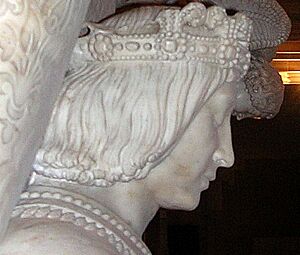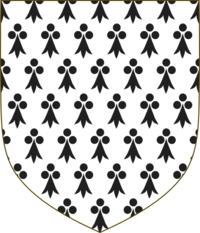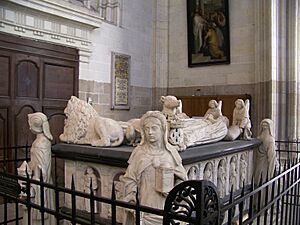Francis II, Duke of Brittany facts for kids
Quick facts for kids Francis II |
|
|---|---|

Sculpture of Francis II on his tomb in Nantes
|
|
| Duke of Brittany | |
| Reign | 26 December 1458 – 9 September 1488 |
| Coronation | 3 February 1459 |
| Predecessor | Arthur III |
| Successor | Anne |
| Born | 23 June 1433 Château de Clisson, Nantes, Brittany |
| Died | 9 September 1488 (aged 55) Couëron |
| Burial | Nantes Cathedral |
| Spouse | |
| Issue |
|
| House | Dreux-Montfort |
| Father | Richard, Count of Étampes |
| Mother | Margaret, Countess of Étampes |
Francis II (born June 23, 1433, died September 9, 1488) was the last independent Duke of Brittany. He ruled from 1458 until his death. Francis was the grandson of John IV, Duke of Brittany.
His main goal was to keep Brittany separate and free from the control of France. This led to many fights with the French kings, especially Louis XI of France and his daughter, Anne of France. These conflicts, which happened between 1465 and 1488, are sometimes called the "War of the Public Weal" and the Mad War.
Contents
Who was Francis II?
Francis was born on June 23, 1433. His father was Richard of Brittany, Count of Étampes. Richard was the youngest son of Duke John IV of Brittany.
Francis became duke because his uncles and cousins, who were older, died without sons. When his uncle Arthur III passed away in 1458, Francis was the only male heir left. This made him the new Duke of Brittany.
How did Francis II help English royalty?
Protecting the House of Lancaster
Francis II played a surprising role in English history. From 1471 to 1484, he protected members of the House of Lancaster. This was an English royal family in exile.
England was in a civil war called the Wars of the Roses. Two families, the House of York and the House of Lancaster, fought for the throne. In 1471, the Yorkists won. The Lancastrian king, Henry VI of England, and his son died.
This left Henry Tudor as the main Lancastrian hope. He was a distant relative to the throne. King Edward IV of England of the Yorkist side saw Henry as a traitor.
Henry Tudor and his uncle, Jasper Tudor, tried to escape to France. But strong winds forced their ship to land in Brittany. Francis II took them in. He saw Henry as a useful tool to get England's help against France.
Francis kept the Tudors safe at the Château de Suscinio for 11 years. He spent a lot of money supporting them. He refused to hand them over to the English king.
In 1483, Francis helped Henry Tudor try to invade England. He gave Henry money, soldiers, and ships. But a storm scattered Henry's fleet. Henry had to turn back to Brittany.
Later, Francis became very ill. His treasurer, Pierre Landais, made a deal with King Richard III of England. Landais agreed to send Henry Tudor back to England. In return, England would send archers to help Brittany against France.
But Henry Tudor was warned. He and his uncle escaped to France just hours before Landais's soldiers arrived. The French king, Charles VIII of France, welcomed them. He saw the Tudors as a way to stop England from interfering with his plans for Brittany.
When Francis recovered, he was upset. He helped the remaining Lancastrians in Brittany get safely to France. Losing the Tudors was a big blow to Francis's plans.
What was Francis II's relationship with French royalty?
Dealing with King Louis XI
King Louis XI of France was known as "The Universal Spider." This nickname showed he was very clever at political planning. He wanted to make France stronger by taking over all the independent duchies, like Brittany.
In 1465, Francis joined the League of the Public Weal. This was a group of powerful nobles. They teamed up against King Louis XI. They wanted to keep their own power and stop the king from taking their lands.
The leader of this group was Charles the Bold, Duke of Burgundy. He dreamed of creating his own kingdom between France and Germany. But Charles was killed in battle in 1477. This was a huge victory for Louis XI. The powerful Duchy of Burgundy became part of France. This weakened the League of the Public Weal.
Francis and Brittany faced more challenges after Louis XI died in 1483. Louis's daughter, Anne of France, became regent for the young King Charles VIII.
Facing Anne of France's Regency
Francis was very worried about keeping Brittany independent while Charles VIII of France was still young. He joined forces with other French nobles who opposed Anne of France. Anne continued her father's goal of bringing Brittany under French control.
Francis also had problems within his own government. His prime minister, Guillaume Chauvin, was replaced by Pierre Landais in 1477. Landais was later executed in 1485 after many nobles, secretly supported by Anne, turned against him.
In 1486, the nobles of Brittany confirmed that Francis's daughter, Anne, would be his heir. This was to help ensure Brittany's independence. In 1487, Francis signed the Treaty of Chateaubriant with France. This treaty was supposed to confirm Brittany's freedom.
But France kept attacking Brittany. The French army captured important towns like Vannes and Fougères. These towns controlled access to Brittany.
The Mad War
Francis then allied with Maximilian I, Holy Roman Emperor, against France. Other lords also sent troops to help Brittany. Alain d'Albret brought 5,000 soldiers from Spain. Maximilian sent 1,500 men. England also sent archers.
However, Francis's forces were defeated on July 28, 1488, at the Battle of Saint-Aubin-du-Cormier. Many of his allies were captured or killed.
A few days later, on August 10, Francis was forced to sign the Treaty of Verger. This treaty made him a vassal of the French king. This meant he had to obey the king. He also had to send away all foreign soldiers from Brittany.
The treaty also said Francis could not freely choose who his children would marry. It also gave parts of Brittany to the French king. This was a guarantee that if Francis died without a son, the king would decide who would rule Brittany.
Francis died just a few months later from a fall from his horse. He left only a daughter, Anne of Brittany. Because of the treaty, Anne was forced to marry King Charles VIII of France. Later, she married King Louis XII.
Even after Francis's death, the Mad War continued for three more years. It finally ended in December 1491 when Anne married Charles VIII.
Francis II is buried in a beautiful tomb in the Nantes Cathedral. His daughter Anne ordered this tomb. It is an important early example of Renaissance art in France.
Francis II's Family
Francis II was married two times.
- His first wife was Margaret of Brittany. They had one son, John, who died shortly after birth.
- His second wife was Margaret of Foix. They had two daughters:
- Anne of Brittany (1477–1514), who became his only child to live to adulthood.
- Isabeau of Brittany (1478–1490), who died young.
Francis also had five children outside of marriage.
Francis II's Legacy
After Francis's death, the nobles of Brittany tried to protect Anne as their Duchess. They wanted to keep Brittany independent, just as Francis had fought for. In 1489, they signed the Treaty of Redon with Henry VII of England. This treaty aimed to stop France from taking over Brittany.
However, in 1491, Charles VIII of France invaded Brittany. He forced Anne to marry him. This gave France control of the duchy. Then, in 1492, Henry VII signed the Treaty of Étaples with France. This meant England would no longer defend Brittany's independence.
Brittany slowly lost its freedom and became part of France. But Anne became a powerful queen. She continued to fight to preserve Brittany's unique identity and her father's legacy.
See also
 In Spanish: Francisco II de Bretaña para niños
In Spanish: Francisco II de Bretaña para niños
- Dukes of Brittany family tree
- Henry VII of England
- War of the Roses
- Other politically important horse accidents



